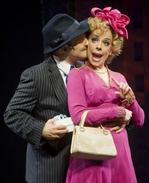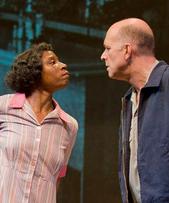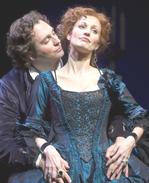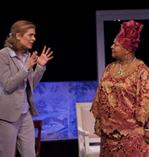SITE GUIDE
SEARCH
REVIEWS
FEATURES
NEWS
Etcetera and
Short Term Listings
LISTINGS
Broadway
Off-Broadway
NYC Restaurants
BOOKS and CDs
OTHER PLACES
Berkshires
London
California
New Jersey
DC
Philadelphia
Elsewhere
QUOTES
TKTS
PLAYWRIGHTS' ALBUMS
LETTERS TO EDITOR
FILM
LINKS
MISCELLANEOUS
Free Updates
Masthead
Writing for Us
CurtainUp In the Berkshires
Barrington Stage Summer 2011 Season
By Elyse Sommer
Note: An asterik indicates that a review is posted Main Stage Shows: Guys and Dolls* | The Best of Enemies* | The Game*
Stage 2 Shows: The Zero Hour | Going to St. Ives | My Name is Asher Lev * |Mormons and Monsters
Barrington Stage
Union Street, Pittsfield
413 236-8888
http://www.barringtonstageco.org Second Stage at the Veterans of Foreign Wars on Linden Street in Pittsfield, near the company's main venue on Union Street. About this All-In-One Format:These omnibus pages for individual theater organizations include facts about the entire schedule even though our limited human resources may not make it possible to review all the shows. However, every show reviewed will be added on this page. If you're looking for something seen in past seasons, click on our Berkshires archives . Also check out our Berkshres news page for news about theaters we don't cover or only occasionally— Berkshire news page and Berkshires Archives-links to past reviews and features .
Main Stage Shows
Guys and Dolls
|
What kind of a doll are you?— Sky Masterson A mission doll!— Sarah Brown |

Michael Thomas Holmes and Leslie Kritzer
(Photo: Kevin Sprague) |
But even an iconic musical is only as good as its performances and staging. While the 2009 Broadway revival featured Broadway-worthy sets, the key players were so disappointingly lacking in Runyonesqueness and pizazz that Loesser, Swerling and Burrows must have stirred uneasily in the heavenly rest reserved for musical theater greats.
Not so the Barrington Stage production. That's the one to have them rise up and dance for joy at how John Rando has recaptured the wonderful fast-moving New Yorkese world of Damon Runyon's stories. with a cast that brings their gambling guys, Hot Box night club dancing girls, and soul saving missionaries back to vivid life. I can't remember a more delicious Miss Adelaide than Leslie Kritzer or a more endearing altar-shy and crap game smitten Nathan Detroit than Michael Thomas Holmes. The forever affianced hustler and Hot Box chorine as well as the large cast make this revival as fresh, fun and full of sizzle as it was when it wowed audiences during its 1200-performance run in 1950.
Of course, this being summer, this Guys and Dolls will have to make room for another show after July 16th (to be specific, a world premiere play by Mark St. Germain), so don't miss the chance to see this production which serves its creators' work on every level. Without spending the mega millions that musicals on Broadway cost these days, Barrington Stage manages to put on thoroughly professional productions that just keep getting better and better. Their handsome, comfortable home in Pittsfield boasts an orchestra pit and seats 500, but retains a sense of intimacy even a big show like this (the cast is more than two dozen strong) with lots set changes and dancing.
Speaking of the dancing, Joshua Bergasse's choreography is on a par with the terrific book and score -- and typical of current custom to move things right along, it begins even as Darren Cohen's musicians strike up the overture. Instead of sitting back and looking at the curtain, that overture turns into a lively dancescape called " Runyonland". As the familiar tunes tickle our ears we see members of the ensemble take on the roles of Runyon's New Yorkers, with the scene including a police chase, some of Miss Adelaide's co-chorines at the Hot Box, and an amusing little old lady who keeps getting knocked over. (This scene is bookended as part of the finale).
Alexander Dodge's sets are incredibly versatile, from the skyscraper proscenium, that flips open to reveal a newspaper stand and telephone booth as called for, and allows the action to shift from street scenes, to the Salvation Army mission headquarters, to the Hot Box stage and Miss Adelaide's dressing ro0m, all the way to Havana — and the piece de resistance descent into the sewer for the crapshooter's big game and dance. Rui Rita's lighting enhance all these apt visual pictures, as do Aleja Vietti's colorful costumes.
While anyone not familiar with the show may think all these set changes involve a complicated plot, it really couldn't be simpler. The songs and dances are built around Runyon's caricatures of gamblers, chorines and Salvation Army workers, chief among them the bumbling but likeable hustler a Nathan Detroit and the handsome, charismatic Sky Masterson (a handsome and charismatic Matthew Risch). They play their games and lose their hearts to Miss Adelaide and Sergeant Sarah Brown (Morgan James) of the Save-A-Soul Mission, respectively; the plot complicating big game being a thousand dollar bet that Sky can charm Sarah to have dinner with him in Havana.
The ever-lovin' ever-fianced Adelaide is probably the character whose nasal Laments everyone who knows the show looks forward to most. But while Krizer is superb, Morgan James brings charm and a rich, lyrical soprano to the role of Sarah Brown. Kritzer and James team up delightfully for "Marry the Man Today." The other characters orbiting around these two couples all do justice to their parts and the rousing numbers the get to sing — from Daniel Macus's very nice Nicely-Nicely Johnson to Peggy Pharr Wilson's General Cartwight who gets the sure-fire 11th o'clock number " Sit Down, You're Rockin' the Boat."
This is my first Berkshire show of the 2011 season. A great start! I can't wait to revisit the season's other musical, v a Barrington Stage originated epistolary romance, The Game, whichv premiered while they were still mounting shows in a high school auditoriam.
Some Thoughts on Damon Runyon: The Chronicler of Broadway's Hustlers, Gamblers and Showgirls
Production Notes
June 15, 2011 - July 16, 2011.
Book by Jo Swerling and Abe Burrows. Music & Lyrics by Frank Loesser.
Based on "The Idyll of Sarah Brown" and characters by Damon Runyon.
Directed by John Rando
Musical Direction by Darren Cohen.
Choreography by Joshua Bergasse.
Cast: Michael Thomas Holmes (Nathan Detroi)t, Morgan James ( Sarah Brown), Leslie Kritzer (Adelaide), Matthew Risch (Sky Masterson), Daniel Marcus (Nicely-Nicely Johnson), Timothy Shew (Benny Southstreet), Peggy Pharr Wilson (General Cartwright), and Gordon Stanley (Arvide Abernathy); also Chelsey Arce, Evan Autio, Tommy Bracco, Sharona D’Ornellas, Sean Patrick Folster, Steve Konopelski, Chris Lebeau, Brooke Marinovich, Michael Nichols, Kellyn Uhl, Nicky Venditti and Correy West
Scenic design by Alexander Dodge
Costume design by Alejo Vietti
Llighting design by Rui Rita
Sound design by Ed Chapman
Renee Lutz is production stage manager.
Orchestra: Richard Downs (Bass), Sue Dunbar (Reeds), Peter Grimaldi (Trumpet), Bruce Krasin (Reeds), Adam McDonald (Asst. Musical Director/Keyboards), Jeff Roberts (Percussion), Jeff Stevens (Trumpet), Dave Wampler (Trombone).
Reviewed by Elyse Sommer based on June 28th performance
Musical Numbers Act One: Opening (Runyonland). . .Fugue for Tinhorns. . .Follow the Fold. . . The Oldest Established. . . I'll Know. . .A Bushel and a Peck. . .Adelaide's Lament. . . Guys and Dolls. . .Havana. . . If I Were a Bell. . ./My Time of Day. . .I've Never Been in Love Before
Musical Numbers Act TwoTake Back Your Mink. . . Adelaide's Second Lament. . . More I Cannot Wish You . . ./The Crap Game Dance. . .Luck Be a Lady. . .Sue Me. . .Sit Down, You're Rockin' the Boa. . .Marry the Man Today. . . Guys and Dolls (Reprise) /
The Best of Enemies
| I'm from the Department of Education. We have a grant to create programs addressing racial issues in our schools. The process is called a Charrette. It's French for meetings between people of different points of view to come to an understanding and we keep meeting 'till they do.—Bill Riddick, to Durham's super bigot, C. P. Ellis, who responds to this sarcastically and tells him to get out. When Riddick persists, by asking him if he doesn't want to stop the violence that's pervaded Durham, Ellis answers I will. As soon as I get my city back..<\br> |

Aisha Hinds and John Bedford Lloyd
(Photo: Kevin Sprague ) |
Mark St. Germain's smart and stirring dramatization of Osha Gray Davidson's 2007 book of the same name proves that fact can indeed be more absorbing and powerful as fiction. That's especially true given that this dramatization is deftly directed by Barrington's founder and artistic director Julianne Boyd and superbly performed by a cast of four.
This 1971 slice of history — the story of how community organizer Bill Riddick managed to force two of the town's diametrically opposed and equally venomous and inflexible leaders to settle what looked like an intractable battle over the desegregation of the Durham, North Carolina schools that was as much about a class as a racial divide — has an all too relevant counterpart in the battle now in a disaster bound stalemate over a budget bill in Washington. If only all those politicians unable to agree on a plan to cut the deficit could be flown to Pittsfield to see this play or send a negotiator like Bill Riddick their way.
Does this sound as if The Best of Enemies is a polemic that is likely to reach an already converted choir? So it is. But luckily, St. Germain is more playwright than preacher; and Boyd's direction, buoyed by topnotch production values and acting, is crisp and inventive enough to make for a riveting drama.
If the story documented in Osha Gray Davidson's book weren't' about real people it would be hard to believe that young Bill Riddick could ever persuade a man like C.P. Ellis spewing the hateful Ku Klux Klan rhetoric and an uneducated but cocky black domestic worker and militant like Ann Atwater to sit down together to do the right thing for their troubled community. It would be even harder to buy into their becoming friends. Yet, there were the real Ann Atwater and Bill Riddick to speak to an audience at a special lecture last Tuesday afternoon and attend the next day's opening. Ellis died in 2005 and considering his initial appearance in the play as a truly detestable KKK Grand Cyclops, you couldn't be blamed for thinking he didn't deserve to live that long. However, St. Germain's script has created a three-dimensional, human monster and John Bedford Lloyd manages to makes his transformation into a man we can sympathize with quite believable. I've seen Bedford Lloyd perform impressively before, but his C. P. Ellis is a true tour-de-force in terms of creating an emotionally dense portrait and talking in an unfalteringly true to type accent.
The outstanding Bedford Lloyd is matched by the dynamic Aisha Hinds, as Ann Atwater, his partner in seeming insurmountable anger and mutual hate, She inhabits Atwater's persona with amazing intensity both in terms of body language and line delivery. While C. P. and Ann are the key figures, there's nothing minor about the contributions of Clifton Duncan and Susan Wands as the outside mediator Bill Riddick and Ellis's wife Mary. Like Ellis and Atwater, Both these characters are not what you see is what you get people. Duncan is wonderful in revealing the permanent scars of his own hardscrabble North Carolina roots beneath the unflappable community organizer. Wands has the least stage time, but makes the most of what she has. It's her scenes with the man she thought infallible when she married him at sixteen but whose obsessive bigotry she sees as a way to avoid being there for her and their children, one of whom is blind and retarded, that reveal the inability to deal with differences and changes of any kind that cause people to stick or be stuck within their own class, economic situation and race. St. Germain wisely keeps Mary's illness from coming off as a mawkish attempt to make Ellis more sympathetic,
The projections (a collaborative effort by scenic designer David M. Barber and sound designer Brad Berridge) and voiceovers (by Berridge) add immeasurably not only to the richness of the production but to place the Atwater= Wells story within the context of the evolution of race relationships in cities like Durham, where industrial growth divided the populace not just into black and white, but the very wealthy and very poor. It is the realization of this have-have not class divide that makes Atwater and Ellis see that they have much in common and gives credibility to their gradually joining forces and, yes, becoming friends. Boyd uses the shifts between the personal and broader political stories to keep everything moving forward seamlessly, with never a dull moment in the intermissionless hour and forty-five minutes.
The Durham crisis plays out over a period of some three years, with an epilogue set at the time of of Ellis's funeral. And while the the misplaced insularity expressed by C.P. when he says that Durham's problem is "letting the Federal Government tell us what to do " can be heard from the folks who support the Tea Party, The Best of Enemies does end happily — that is if you accept change inch by inch rather than in giant leaps. Boyd underplays that inch-like progress with a big heart-warming finale that brings a choir made up of local Berkshire County residents and five Barrington actors on stage to introduce the curtain call. Awell-deserved standing ovation.
If you're not going to be in the Berkshires to see The Best of Enemies during its world premiere run, take heart. Like The 25th Annual Putnam County Spelling Bee, The Whipping Man and Mark St. Germain's own Freud's Last Session, this play has muscular enough legs to show up at other stages.
Production Notes
The Best of Enemies
By Mark St. Germain Inspired by the book The Best of Enemies: Race and Redemption in the New South by Osha Gray Davidson (University of North Carolina, 2007) Directed by Julianne Boyd
Cast: Cast: Aisha Hinds (Ann Atwater), John Bedford Lloyd (C.P. Elis), Clifton Duncan (Bill Riddick), Susan Wands (Mary Ellis) Scenery/Co-Projection Designer: David M. Barber
Costumes: Kristina Lucka
Lighting: Scott Pinkney
Sound/Co-Projection Designer Brad Berridge
Associate Director: Christopher Innvar
Stage Manager: Michael Andrew Rodger s
July 21 through August 6. Reviewed by Elyse Sommer July 27th press opening
August 8th update: Because the play broke all BS box office records and many people were unable to see it, a reprise engagement has beenscheduled to run from October 5-16. Same cast, except that Clifton Duncan who played Bill Riddick is unavailable-- his replacement TBA.
The Game
| Together we're a perfect pair I'm willing, and you're able — Merteuil and Valmont, in the title song that initiates this nasty pair's game of vengeful sexual intrigue, a symbol of the corrupt and depraved aspects of French aristocratic society before the revolution. |

Rachel York and Graham Rowat
(Photo: Kevin Sprague) |
The 1782 epistolary novel Les Liasons Dangereuses embedded the name of army officer Choderlos Laclos on the literary landscape. Crème de la crème adapter Christopher Hampton turned it into a favorite example of the epistolary drama and productions of Hampton's spicy picture of the trivial pursuits of the aristocracy during the reign of King Louis XV have appeared on stage and screen ever since. The most famous in the latter category starred i Glenn Close as the bored and manipulative Marquise de Merteuil and John Malkovitch as a smarmy Vicomte de Valmont. The various stage adaptions Curtainup has reviewed include a Broadway revival three years ago and even an all male version ( Review of the gay Les Liaison Dangereuses).
But it took Barrington Stage's adventurous founder and frequent director, Julianne Boyd, to see the the play's potential as a musical. Not one to just think about a good idea, Boyd worked with book writers and lyricists Amy Powers and David Topchik and composer Megan Cavallari to turn a good idea into a lovely, tuneful production.
The operatic finale and epistolary story telling proved admirably suited for a musical — so much so that when I saw The Game eight years ago when Barrington Stage was still located in a high school auditorium I found it surprising it hadn't been musicalized before. Yet, despite the enthusiastic reception by theater goers and critics, it took Boyd to once again give it life, this time in her beautiful theater in Pittsfield. The current production, again helmed by Boyd, is, if anything, more beautiful than ever, with a more lavish set by Michael Anania, the original designer, that's richly enhanced bu Jeff Croiter & Grant Yaeger's lighting and Jennifer Moeller's costumes mouth wateringly gorgeous and true to the period costumes. The 23 scenes include several big, knockout production numbers like "The Opera" and "Just Past Midnight. " Of course, a musical can't rely on its looks but needs a good book and music and, above all, a strong cast to speak the dialogue and sing the tunes.
No worries about the 8-member cast (plus Ensemble) here. Boyd has once again found a terrific pair of mischief-making aristocrats in Rachel York and Graham Rowat. York brings nuance and stage presence to the outwardly charming and beautiful but vicious and bored Marquise de Merteuil . If there's a flaw in her smoky voice is that it tends to turn shrill when a song hits the upper registers. Graham Rowatt, has a strong voice and is handsome enough to make his powers of seduction believable. He also manages to make the disillusioned nastiness of the Vicomte deValmont and the regret that ultimately turns his affair with the malevolent Marquise credible.
York and Rowat are ably supported by the rest of the cast large enough to fill the stage but economical when compared to most Broadway musicals. All are given excellent musical support by the 7-member pit band headed by Darren Cohen. The musicians enhance the songs without drowning out the lyrics.
Of the performers playing de Merteuil and Valmont's victims, Joy Franz, the only cast member from the 2003 production, as Valmont's wise (but not enough so) aunt Madame de Rosemonde. Her rendition of "Certain Women" is one of the show's most memorable songs. First sung as — as a duet with Merteuil, it deserves the reprise it gets in the second act, this time with Valmont's second victim, the devout but vulnerable to his charms Madame de Tourvel (Amy Decker who's not only lovely but brings strong emotion and musical range to several numbers, most notably "My Sin"). Also well cast is Sarah Stevens as young Cecile who has the bad luck to be targeted for deflowering by Valmont. Like Ms. York, her voice tends to turn shrill on the high notes. Chris Peluso brings fine tenor voice and great charm to the role Danceny, Cecile's music teacher and hapless suitor.
Boyd's talent for smoothly transitioning from scene to scene is especially on display in the segues between from writing-out-loud dialogue to song. As to whether some trimming and rearrangement of some songs have given this show the legs needed for it to have a po-Barrington Stage life, the fact that it has a Broadway-ish look without a super expensive Broadway sized cast and orchestra is in its favor. However, though the score is refreshingly melodic and features some stirring tunes, it still lacks one really stick-to-the-ears, hummable anthem, though " Certain Women," "My Sin" and "Finally, Finally" are certainly show stoppers; and while the music has its roots in opera with a Sondheimian flair, the lyrics come closer to popera. Whatever The Game's future, it's present permutation is a grand finale to one of Barrington Stage's most successful seasons. Definitely not to be missed.
Production Notes
The Game based on the novel Les Liaisons Dangereuses
Directed by Julianne Boyd
Musical score by Megan Cavallari
Book and lyrics by Amy Powers and David Topchik.
Choreography: Daniel Pelzig
Musical direction by Darren R. Cohen.
Cast: Starring Rachel York (Marquise de Merteuil) and Graham Rowatt (Valmont); also Amy Decker (Madame de Tourvel), Joy Franz (Madame de Rosemonde), Christianne Tisdale (Madame de Volanges). Chris Peluso (Danceny), Analisa Leaming (Emilie and Ensemble), Taylor Anderson(Opera Singer and Ensemble) and Stephen Horst (Azolan, Opera Singer and Ensemble); Michael Hewitt, Hannah Richter, Amanda Salvatore, Michael Wessells (additional Ensemble members.,
Scenery: Michael Anania
Costumes: Jennifer Moeller
Lighting: Jeff Croiter & Grant Yeager
Sound: Ed Chapman
Fight Director: Ryan Winkles
Orchestrations: Mike Morris
Stage Manager: Renee Lutz
Running Time: 2 1/2 hours including one intermission
August 11 to August 28th
Reviewed by Elyse Sommer at 8/17 press opening
|
Musical Numbers
| |
Act One
|
Act Two
|
Stage 2 Shows
May 18 through June 5. -- extended for 2 weeks after sold out Memorial Day weekend The Zero Hour Jim Brochu's solo homage to Zero Mostel -- The Zero Hour -- you can catch it in Pittsfield when it kicks off Barrington's Stage 2 season from
Going to St. Ives
|
As I was going to St. Ives I met a man with seven wives, Each wife had seven sacks, each sack had seven cats, Each cat had seven kits: kits, cats, sacks and wives, How many were going to St. Ives? |

Myra Lucretia Taylor, above, and Gretchen Egolf.
|
The Blessing play that has garnered the most unanimous praises was his 1988 Tony Award and Pulitzer Prize-nominated A Walk in the Woods. My own favorite is probably the experimentally structured, gay-themed Thief River one of my viewings of which was at Barrington Stage in 2004 when their second stage was still in a high school gym
Barrington Stage's production of Going to St. Ives at their handsome smaller theater in Pittsfield is also my second viewing, but with two different actresses,, director and production teamx. The play remains worth seeing mostly for the performances but ultimately too sluggish and contrived to be entirely satisfying, this review is, for the most part a repeat, of the one I wrote my when I saw it at Primary Stages in New York. The play is basically a two-person debate, shades of Walk in the Woods. The global problems explored here revolve around the violence that has been the bitter harvest of many parts of post-colonial Africa.
The characters are two strong-willed women, a British eye surgeon, Dr. Cora Cage (Gretchen Egolf), and May N'Kame (Myra Lucretia Taylor), the imperious mother of an African dictator reminiscent of Idi Amin. who has made himself an emperor and her an empress. Their talks don't take place during a walk in the woods, but over that most civilized symbols of polite social intercourse -- a cup of tea, poured first in a simple but elegantly furnished home in St. Ives, outside of Cambridge, and in the second act in the garden of an unnamed country in central Africa.
The first tea party is prompted by the African woman's urgent need for an operation to save her sight. The medical emergency is, of course, just an excuse to allow more far-reaching ideas to gain altitude within the play's intimate framework.
The doctor has invited the African Empress to her home, ostensibly to make her feel more relaxed about the impending surgery. May, is hostile and suspicious, well aware that she is putting her most precious possession, her sight, into the hands of a woman who no doubt shares her countrymen's disdain for the mother of a man they regard a monster.
Cora, does indeed have another motive for asking May to tea. She wants her to use her influence to save some African doctors from being put to death for their unwillingness to keep prisoners alive to endure horrendous torture. Her plea for intervention prompts May to propose a Faustian quid pro quo. The fact that both women are weighed down by guilt pertaining to their sons (Cora feels responsible for her young son's accidental death enroute to a Los Angeles sporting event; May sees herself as the vessel of a bad seed) threatens to turn this into a soapy melodrama.
Experienced playwright that he is, Mr. Blessing manages to establish his premise with a provocative first act. Though there are just two actors on stage, there's plenty of dramatic tension. The dialogue crackles with timely quandaries. Everything builds towards that initial tea party's tense brinksmanship clash between responsibility for many and the Hippocratic oath. Fortunately director Tyler Marchant has enlisted two excellent actresses and directed them to make the most of that dynamic first act and prevent the less credible second from collapsing under the weight of its too drawn out predictability.
In her brilliantly colored African garb, Myra Lucretia Taylor is the very embodiment of the word regal. in her simple well-tailored suit, Gretchen Egolf is the sparrow to Taylor's bird of paradise. Though Taylor's part is more flashy, Egolf more than holds her own. Just watching the verbal sparring makes you realize how much is lost in all those solo shows that don't allow at least one other action to make the strong connection of having at least two performers on stage.
I'm not spoiling any surprises when I tell you that all the talk about the classic Willow Pattern china Cora inherited from her grandmother is a careful plant for the second act revelation that shards of this old china were mixed with mortar in her garden —- Blessing's way of making a symbolic point about the need to aid and bolster what has been abandoned.
While Brian Prather expertly shifts the scene from England to Africa after the intermission, the second act is disappointing. Except for a heartwrenching monologue, powerfully delivered by May, it moves at a much more lethargic pace with the plot contrivances more obvious. As the return to the Willow Pattern china is easily anticipated so is the title's connection to the schoolroom rhyming puzzle quoted at the top of this review. The answer to the question of how many of a much married man's wives would be going to St. Ives (which is, of course, "one" — ) and it doesn't take Sherlock Holmes to connect this to the inevitable final fork in these women's, and the world's, moral journey.
Despite its manufactured plot, Going to St. Ives takes a very realistic view of the possibility for less turmoil in emerging nations. And while it is a play of ideas, with Ms Egolf and Ms. Taylor to preside over the tea table, it's very much the actors' show.
Production Notes
by Lee Blessing
Directed by Tyler Marchant.
June 22, 2011 - July 9, 2011
Cast: Gretchen Egolf and Myra Lucretia Taylor
/Sets by Brian Prather
Costumes by Kristina Sneshkoff
Lighting by Scott Pinkney
Sound by Allison Smartt
Stage Manager: Michael Andrew Rodgers.
Running time approx. 2 hours including one intermission
Saturday 4pm and 8pm. Sunday 3pm Additional matinee: Thursday, July 7 at 3pm
Reviewed by Elyse Sommer
My Name is Asher Lev
|
Why do you think you are responsible to the Jewish People?—Kahn All Jews are responsible, one to the other. It is in the Talmud. My father — Asher As an artist you are responsible to no one and nothing except to yourself and to the truth as you see it! t An Artist is responsible to his art. To his art! Just that.—Kahn |

Daniel Cantor and Adam Green
(Photo by Kevin Sprague) |
audiences will find it a fitting finale for Barrington Stage Company's hit after hit season
While Yiddish words and Hasidic dogma permeate the play, this is a universal story, of a young man torn between the demands of his ultra religious upbringing and his need to fulfill his extaordinary gift as a painter. You don't have to be Jewish to relate to the conflict between a powerful, single-minded father and a son for whom following in his footsteps would mean not being true to the equally powerful pull for fulfilling his extraordinary gifts as an artist.
Posner, who also directs, has used the novel's first person structure so that the actor playing the title character is constantly on stage. This may sound like a biographical monologue, but the adaptation, while leaning heavily on the title character as narrator, has also provided him with two other actors. to play a variety of men and women. Their presence transforms Asher Lev's story into an intense, emotionally powerful drama. With the help of Daniel Conway, who also designed the Wilma Theater premiere, Mr. Posner has supported the actors with a simple but extremely effective multi-purpose set.
In her review of the premiere production, Curtainup's Philiadelphia critic Kathryn Osenlund heaped praises on the actors as well as the staging. While Mr. Posner is now working with a different cast, he has once again elicited spectacular performances and Kathryn's accolades for that first production overall apply to the drama unfolding at Barrington's Second Stage.
Asher introduces himself as an adult who's both an observant or Torah Jew as well as a famous painter — infamous to Orthodox Jews thanks to a series of paintings named "Brooklyn Crucifixion." His struggle to grapple with the demands of the Jewish community in Brooklyn, the only world he knows, and his emerging creative impulses is told in a flashback that begins very early on. Asher shows signs of being a prodigy when he's only 5-years old. Ari's strict father, whose harsh words at times smack of child abuse, is unable to square his son's gift with his belief system. Although as Asher gets older he denounces his father's attitude as "aesthetic blindness," hef struggles with his responsibility to his people, his art and to the truth. By the time Asher is bar mitzvah age he rebels against moving to Vienna because of his father's work. He finds a surprising champion in the Rebbe who is the ultimate arbiter of everything, even familial disputess. It is the Rebbe's decision to send Ari Lev off without his wife and son and see that Asher is mentored by a famous artist, Jacob Kahn, that paves the way for his future .
Under Kahn's tutelage Asher becomes the artist he's meant to be. This will culminate with his having the courage to paint his masterpiece, "Brooklyn Crucifixion." That painting sums up his mother's pain at being the peacemaker between her son and her husband which at one point has her telling her son "You exhaust me. You have no idea what it is like standing between you and your father." It's the painting he must paint even though he knows it will devastate his parents.
Although the mix of narrative and vignette structure doesn't break any new ground, it's masterfully employed by the adapter-director to move in and out between the first person delivery of events and emotions and interactive scenes that dramatize what's been said. The play's shape is enhanced by the carefully chosen and compressed dialogue
Adam Green gives a powerhouse performance as Asher Lev. Daniel Cantor plays all the male roles besides Asher. His segues between the stern, demanding Orthodox father and the completely different artist-mentor Kahn are fascinating and totally believable.
Renata Friedman as the "Woman" also metamorphoses into several characters quite different from her dominant role as Asher's mother. Her brief nude scene is not gratuitous and is handled with suitable subtlety.
Though this is a play concerning art, Mr. Posner's decision not to clutter the set with actual art works beautifully. Whether we see young Asher's drawings or his framed exhibited art, the sheets of drawing paper are blank and the frames empty. Perfect! Perfect is also the adjective to describe John Hoey's mood setting lighting.
My Name Is Asher Lev is an intricate story of a son who must leave the cocoon of a narrow world to find his own place in another world -- one which his parents, especially his father, can never really understand. It's a long, involved and involving story, presented with economy, intelligence and emotional heft. Highly recommended!
Production Notes
My Name Is Asher Lev
Adapted from novel by Chaim Potok Aaron Posner, who also directs
Cast: Daniel Cantor (The Men), Renata Friedman (The Women) and Adam Green (Asher Lev).
Sets: Daniel Conway
Costumes: Olivera Gajic
Lighting: John Hoey
Sound: James Sugg
Stage Manager: Rose Marie Packer
Reviewed by Elyse Sommer at 8/21 press opening
From August 18 through September 11 (a one-week extension due to pre-opening ticket demand)
MusicalTheatre Lab Mormons and Monsters a quirky musical comedy-- NOT to be confused with the Broadway musical The Book of Mormons
Production Notes:
Mormons Mothers and Monsters
Music by Will Aronson and book and lyrics by Sam Salmond
Directed and Choreographedby Adrienne Campbell-Holt
Cast: Stanley Bahorek (Me), Taylor Tensch (Mormon), Jill Abramovitz (Mother), Adam Monley (Moster/ Dads).
Scenic Design, Brian Prather
Costume Design: Paloma Young
Lighting Design: Grant Yeager
Sound Design: Ryan Peavey
Musical Direction: Vadim Feichtner
Musical Theatre Lab Artistic Producer: William Finn
Visit CurtainUp's Friends


Slings & Arrows-the complete set
You don't have to be a Shakespeare aficionado to love all 21 episodes of this hilarious and moving Canadian TV series about a fictional Shakespeare Company



Slings & Arrows-the complete set
You don't have to be a Shakespeare aficionado to love all 21 episodes of this hilarious and moving Canadian TV series about a fictional Shakespeare Company

